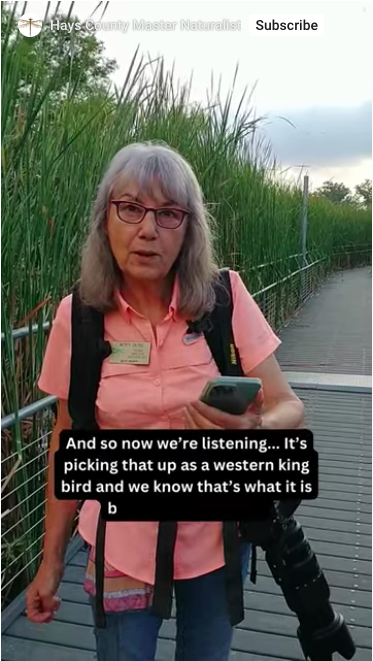Reaching all of Hays County
Irene Foelschow
Ever since I certified as a Hays County Master Naturalist, something weighed on my mind: we have programs for adults who are already interested in nature and land management (The Hays Humm, HELM, and of course our own Training Program) and many wonderful events and resources for children (The Coloring Book, Emily Ann Theater, and Bamberger Ranch, to name a few), but what about the 255,000 people living in Hays County who aren’t really thinking about the natural environment on a day to day basis? How can we possibly reach those folks with only 300 or so active volunteers?
As a small local nonprofit, we don’t have a lot of funding, but we are blessed with wonderfully motivated and knowledgeable volunteers. Social media is an ideal match because it’s free to share as much content as we’d like! We found that in recent years, YouTube has surpassed even Facebook as the dominant social media platform with 81% of Americans using the video service.
Thus, our Video Team was born! Our goal is to give folks pride in our natural resources with a mix of humor, wonder, and education. Ultimately, we’d like to foster a sense of environmental responsibility among all those who live, work, and play in Hays County.
Our first fan favorite, Crazy Nature Shorts: The Dung Beetle by John Moore and Pat Heintz
Even though most of our volunteers joined the team with no video or social media experience, they were soon creating engaging educational content.
Martha Sanders created our first big hit when she diligently tracked two monarch cocoons and caught a butterfly’s first flight on camera!
Monarch Wonder by Martha Sanders
A new strategy
From there, we hit a little bit of a lull and went back to the drawing board to do more research and sharpen our strategy. That’s when we struck on the idea of a 90 video shorts in 30 days campaign.
Video shorts have multiple advantages. First, they’re less than 60 seconds. Information in bite sized pieces is much more approachable for those just getting introduced to ecological concepts. Also, making shorter videos is much less daunting for our newbie volunteers!
The other things that make vertical video shorts great is their discoverability:
We can post the same video across YouTube, TikTok, and Instagram.
The algorithm for vertical shorts favors local content for local users.
Vertical shorts are much more likely to be seen by passive viewers as they scroll, even if they aren’t specifically searching for our content.
Okay, but why 90 videos in 30 days? Well, our research says we’re most likely to find success with vertical shorts if we post 3-5 times a day for a month!
Making 90 videos
Up until this point, the most content our team had produced in a month was four videos. After presenting our extremely ambitious goal, the team came through with an amazing 45 videos in just one month. In a little over two months from our plan’s inception, we’ve stockpiled enough videos to launch our campaign. I’m so incredibly proud of our team. We’re just about halfway through our thirty days at this point. Here are some of the highlights so far:
Live the Silverleaf Nightshade Saga with Katie Peltier
Binge on Nom Nom Natives with Allison Buckner
Come along with Hays Humm editor, Betsy Cross, as she takes some photos for this e-magazine
Rock and Roll with Bret Fossum
And more!
There’s so much more I couldn’t fit here, plus all the videos that are scheduled for the second half of our 30 days! Enjoy Allison Buckner and Bill Dupre’s haikus, catch Master Naturalists in the wild, and attract birds with Doray Lendaky (to name just a few). It’s definitely worth stopping by YouTube, TikTok, or Instagram to see the rest.
What’s next?
We don’t plan on stopping when we hit 90 videos. Obviously, we’ll continue to make shorts, and our volunteers will branch back out into longer-form horizontal content. I’m particularly excited to see Jo Korthal’s video on how to walk your cat on leash so that it doesn’t eat or get eaten by native animals.
We’re continually finding new ways to use these video media platforms to our advantage. We’ve been experimenting with livestreaming chapter meetings to make them publicly accessible and using the vertical shorts licensing agreements to include popular music legally and freely in some of our more experimental content.
Your views, likes, subscribes/follows, and comments very much help boost our visibility. Please stop by our YouTube, TikTok, or Instagram channels when you have the time. We’ll do our best to make the videos worth your while!



















